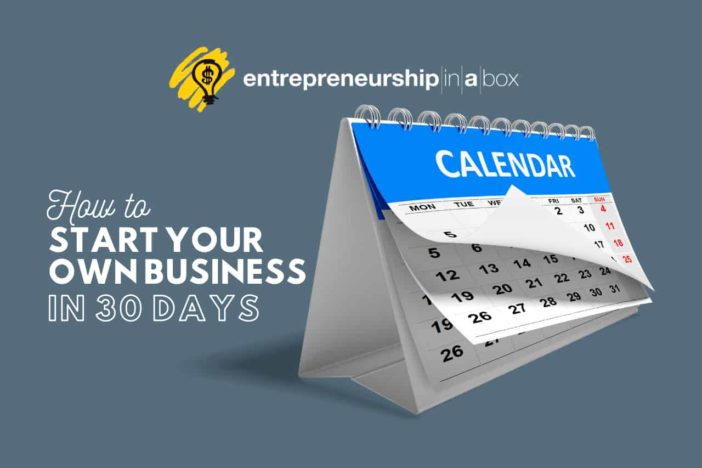Can you start your own business in only 30 days with a high potential for success? The business startup period for each company quickly can become a nightmare for an entrepreneur. There is a need for different activities to perform if you want your business idea to become a reality.
For example, the first thing you need to do is overcome the fear of starting your own business.
During the startup period, one crucial question is how much time you will need as an entrepreneur for your business to become a reality. Thirty days to start your own business is enough period for all critical tasks you need to perform, but this is not true for all types of businesses. Some businesses you can start in a shorter period and some over a larger period.
Here is a list of activities you need to do if you want to start your own business in 30 days. For each day, one task that you must perform.
Start a Business Day 1: Collect different business ideas
All companies are something that began on some entrepreneurial business idea. If you want to start your own business, you will need to spend the first day of your entrepreneurial journey brainstorming different business ideas to transform into a successful business. On this day, you must brainstorm business ideas as much as possible. I’ve already written different posts about developing good business ideas:
- 50 Questions to Develop Business Idea – Post about business idea development process through answering 50 different questions.
- Three Must-Have Things for Business Ideas – Three things that you must include in your business idea for building a successful business.
- Business Ideas Book Template – Template that you can use to collect different business ideas.
- The Best Resources Where You Can Find Business Ideas – Some web resources that you can browse to find different business ideas.
- How To Find a Business Ideas That Match Your Skills – Finding business ideas that will be compatible with your skills.
- 6 Tips To Increase Creativity For Good Business Idea – How to increase creativity for developing the best business ideas that you can start.
Read this list of posts and use them to brainstorm different business ideas. Next, take a notepad and write them down in the business ideas book template.
Related: 4 Steps Business Idea Generation Process in Entrepreneurship
Start Your Own Business Day 2 -3: Analyze Business Ideas That You Brainstormed Yesterday
Spend the second and third days analyzing the business ideas that you brainstormed yesterday. I want to use one measure that will explain to me who are the best business ideas. This measure is a business potential energy that all brainstormed business ideas can have inside them. You can read more about this technique of analyzing business ideas in:
- How to Measure Business Potential Energy of Your Business Idea – Simple process that uses four different metrics for the purpose of analyzing already brainstormed or collected business ideas.
Start Your Own Business Day 4: Choose the Best Business Idea
In the previous three days, we collected business ideas and analyzed them. Now it is time to pick one idea that you will start as your business. You can choose a business idea with the highest possible business potential energy within it. Use the example in the article about measuring the business potential energy of your business idea that I mentioned in the previous day – day 2-3.
At the end of this day, you must be clear about what business you will start.
Related: How to Start a Food Delivery Business from Home
Day 5: Determine the Ownership
If you want to start a business with a partner, it is better to determine real ownership in these startup days than later when the business will start to make money. Here are several different questions that must you will need to answer related to the ownership:
- Whose idea was to start a business?
- How much money will you invest?
- Who will work and what will work?
Talk with business partners about clear answers to these questions. Then talk with your partners about all legal issues relating company’s ownership. At the end of this day, you will have the percentage of the ownership of all your business partners.
Start a Business Day 6: Create Initial Agreement about Ownership
Yesterday you outlined the ownership of the firm. On the sixth day, it is time to make an initial agreement with your business partners. In this agreement, you must include the most critical points about ownership that you outlined yesterday (investments in money, the percentage of ownership, investing time in the business startup, and working activities for the future).
Day 7: Brainstorm and Choose the Best Business Name
Maybe this sounds like a simple task, but remember to give enough attention when brainstorming a business name. Start with a simple brainstorming session for possible names that can create an accurate picture of your business and the personal image that you want to build. Think about how the business name will make a difference and uniqueness from your future competitors.
Start Your Own Business Day 8: Design a Good Logo
The logo is the second identification element of your future business as an addition to the name. When customers think about your business in their brain will appear your visual identification – your logo. Spend this day designing some good logo that you can use as a visual identification of your company.
Day 9: Think, Brainstorm and Choose Business Slogan
The business slogan is a third identification element of your business as an addition to the name and logo. Spend this day brainstorming different slogans for the business. A good slogan can be easily connected with your business, and your customers can easily remember it.
Day 10: Make Initial Market Research
You need to understand why customers will buy specific products and services because there are many different reasons. Some customers buy for one reason, another for another reason. Market research is essential for any business that wants to offer products or services in a particular market or market niche. Spend this day to do initial market research. You can read more about market research in:
Day 11: Make Initial Sales Forecast
Spend this day to make initial sales forecasts. The sales forecast is a prediction of sales figures that you will calculate from the market research data and will expect your business to achieve in the future. You can use a sales forecast template.
Day 12: Make Initial Expense Budget
Today it is time to make an initial expense budget for the business. Include rents, marketing costs, utilities, payroll, and all other costs that you will make in some time while you are a startup business. Use monthly estimates of expenses.
Day 13: Calculate Your Startup Costs
When you have finished with the initial expenses that you made the previous day, you can start calculating startup costs. Use all costs you must pay before your startup opens the door and all assets you need to have after the startup stage.
Day 14: Make Business Plan
You’ve already made different parts of your business plan as sales forecast, expenses budget, and startup costs. Now you can add all of these things into one business plan. Additionally, you must include some tasks that must be accomplished in the future and make an organizational chart with different positions of different people in the business. Include cash flow analysis into a business plan combining the data from sales forecast and expenses.
You can read more about business planning in:
- Your Ultimate Guide to Build a Basic Business Plan Template
- Business Planning – Something that Increase Business Potential Energy
- Business Plan – How to Measure Results?
- Integrated Business Planning – Solution for Chaos in Planning
Start a Business Day 15: Make Marketing Plan
Writing a marketing plan is not a simple task. But, it will help you to know what steps you need to take to attract enough customers, the right customers, or prospects for your business. Spend this 15th day to make a good marketing plan and use some of these marketing ideas. You can read more about the marketing plan in:
Day 16: Build your website
Today we cannot imagine a business without an online presence. A first, you must decide on the type of website that you will use. Do you want to have a static website with some information about products and services and contact details, or do you want a dynamic website in the form of a blog? You can choose to design something today using different templates on the web, or you can hire a technical person that will transfer your ideas to the website in the HTML files.
Here are some resources that you can use for the accomplishment of the task today:
- Internet Marketing Objectives for Your Business – Primary and secondary objectives for an online presence.
- 10 Advantages of Using Blogs for Your Business – Help in choosing the type of website that you want to implement for business purpose.
- 10 Blog Topics that You Can Write for Your Business – If you decide to use a blogging platform as your website, here are ten blog topics that you can use for business purpose.
Day 17: Start building presence on the most relevant social media
Today’s task to start your own business is to start creating accounts on the most appropriate social media that will help you spread the message about your new venture. Now you must decide what social media you will use, make profiles on them, and customize them.
You can choose different sites that compare the popularity of various social media.
Related: How to Start a Streaming Music Business: Building an App Like Spotify
Start Your Own Business Day 18: Analyze and choose the location
Today’s task that you will need to accomplish is to find an ideal place where you will locate your new venture. Before you start searching, you should first describe the location that will be perfect for your new business and note all desirable criteria that the location must comply with. Different types of companies will require different location criteria.
When you become clear about location, start searching and choose one. It would be best if you avoid these mistakes:
- Select location because it is close to your home. The home is not important about your location. Importance is about customers and all operating requirements.
- Choose location only about price. The location is an essential element of your new venture that can impact on your overall business potential energy.
- Choose location only because of you. Without accomplishment of desired criteria, your location is not good for your business.
Day 19: Make agreement for the location
When you choose the location that will be ideal for your new business, now you must contact the owner and make a legal agreement. If the location is excellent, try to make a long-term deal.
Day 20: Start building the team
Who will work with you? Who will be salespeople? What about administrative tasks? Think about the ideal team that can bring many victories for your company. You can have the best technology, the best products or services, the best marketing activities, but without human resources, your business will be nothing.
Today start building a list of possible people that can work for you and contact them to make an initial agreement.
Start a Business Day 21: Talk to everyone about your business
Today start with the initial promotion of your new venture before the real startup. Go to your cousins and friends and talk about what you will work for and what benefits the customers will have from your business. Speak with every person that you know and meet on the street or at some events. The purpose is to introduce your future company to all people you know and can be potential customers.
Day 22: Set up a bank account
Today you must decide about the bank where you will want to open a bank account. Think about services that you want to have from your bank. Select the best and open a business account.
Day 23: Legalize your new business
Now is the time to make your business legal. Make a study for national legislation about the required documentation and activities that you must perform to legalize it.
For example, if you want to become a personal trainer, you will need certifications and other documents required by the legislation where your business will be based. So, you need to analyze legislation or find a lawyer to help you with all the necessary steps and legal documents.
Today, you need to accomplish this task.
Day 24: Make business cards
Business cards are a valuable promotional weapon for all business startups. Today your task is to make your cards that include a logo, slogan, contact details, and your name and surname.
Day 25: Make promotional materials like brochures and flyers
When you finish with business cards, start with initial promotional materials as brochures and flyers. These early promo materials must introduce your new venture to the market or community where it will operate. It would be best if you made impressive brochures and flyers. If you cannot, hire a professional to make them for you.
Start Your Own Business Day 26: Plan opening event
Today’s task is to create a plan for the opening event. How many people can you invite? Who will be invited? What will be in the opening program? Answer these questions and make a plan for all tasks that you must accomplish with deadlines.
Day 27: Create a buzz about your opening event
Today you must start creating a buzz about the opening event. Use social media that you chose previously. Talk with all people about that great opportunity that will change their life. If you build great buzz around your business startup, you will increase your potential energy for the future.
Day 28: Make invitation for opening event
Today your task is to make invitations for the opening event of your company. Yesterday, you built a buzz about your business startup that will make people starving to see how you can change their life with your new business.
Day 29: Invite as much as possible guest on opening party
You have a plan with a note of how many people you can officially invite to an official business startup. Send them invitations that you made yesterday. If you have more people at your opening party, the more probable it will be that you will have more customers from those guests on opening day.
Day 30 to start your own business: Start selling
When you finish everything, you can start your own business. The most critical thing in the following months or a year is selling. Sell, Sell and Sell.
That’s it! These are 30 days that you will need to start your own business.
Sometimes you can finish several days in one day, but some tasks will require more days. The required time will depend on the type of company, as I have mentioned earlier. However, if you need an additional day to complete some of the tasks to start your own business, you are free to use them. Don’t limit yourself with this schedule.





